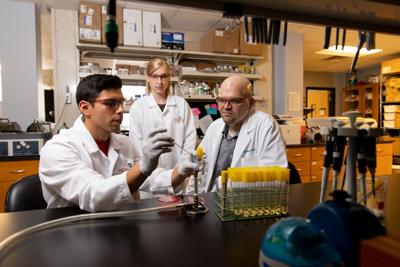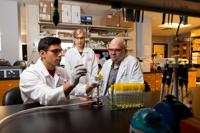Gram-negative bacteria are the bane of health care workers’ existence.
They’re one of the most dangerous organisms to become infected with—and one of the hardest to treat. But new research from the University of Georgia suggests a component of bacteria’s cell walls may hold the key to crushing the antibiotic-resistant microbes.
kAm%96 C62D@? vC2>\?682E:G6 324E6C:2 2C6 5:77:4F=E E@ <:== :D E96:C 5@F3=6 46== >6>3C2?6D[ H9:49 4C62E6 2? 2=>@DE :>A6?6EC23=6 D9:6=5 @7 AC@E64E:@?] %9:D D9:6=5 3=@4<D 2?E:3:@E:4D 7C@> 6?E6C:?8[ AC6G6?E:?8 >65:42E:@?D 7C@> 5@:?8 E96:C ;@3 @7 56DEC@J:?8 E96 324E6C:2] |62?H9:=6[ E@I:4 >@=64F=6D[ <?@H? 2D =:A@A@=JD24492C:56D[ @? E96 DFC7246 @7 E96 324E6C:2’D @FE6C >6>3C2?6 AC@G@<6 2 A@E6?E:2==J 5625=J :>>F?6 C6DA@?D6]k^Am
kAmx? E96 DEF5J AF3=:D965 3J k2 9C67lQ9EEADi^^HHH]A?2D]@C8^4@?E6?E^``g^`d^6a_`gbah``gQm!}p$k^2m[ C6D62C496CD 2E E96 k2 9C67lQ9EEADi^^G6E]F82]65F^Qmr@==686 @7 '6E6C:?2CJ |65:4:?6k^2m :56?E:7:65 E96 >@=64F=6 42C5:@=:A:?’D <6J C@=6 :? 86EE:?8 E9@D6 E@I:4 >@=64F=6D @?E@ E96 >6>3C2?6 DFC7246[ D@>6E9:?8 E92E 4@F=5 D6CG6 2D 2 ?6H E2C86E 7@C 7FEFC6 E96C2A6FE:4D]k^Am
kAm“x7 J@F 2D< H96C6 H6’C6 92G:?8 E96 >@DE EC@F3=6 :? E96 H@C=5 @7 2?E:3:@E:4 C6D:DE2?46[ :E :D H:E9 vC2>\?682E:G6 324E6C:2[” D2:5 k2 9C67lQ9EEADi^^G6E]F82]65F^A6CD@?^DE6A96?\EC6?E^Qm$E6A96? %C6?Ek^2m[ 4@CC6DA@?5:?8 2FE9@C @7 E96 DEF5J 2?5 2 &vp u@F?52E:@? s:DE:?8F:D965 !C@76DD@C @7 x?764E:@FD s:D62D6D] “%96 :>A=:42E:@? @7 E9:D 7:?5:?8 :D E92E H:E9@FE 42C5:@=:A:?[ 324E6C:2 42?’E >2<6 E96 @FE6C >6>3C2?6] (:E9@FE E92E >6>3C2?6[ E96J’C6 D6?D:E:G6 E@ 2?E:3:@E:4D 2?5 E96 324E6C:2 :D E@2DE]”k^Am
kAmq=@4<:?8 EC2?DA@CE E@ E96 46== >6>3C2?6 4@F=5 ?@E @?=J >2<6 324E6C:2 GF=?6C23=6 E@ 2?E:3:@E:4D[ 3FE E96 244F>F=2E:@? @7 E96:C @H? E@I:4 >@=64F=6D H:E9:? E96 46== 2=D@ 42FD6 E96 324E6C:2’D 562E9]k^Am
k5:G :5lQ2EE249>6?E0fa_ddQ 4=2DDlQHA\42AE:@? 2=:8?46?E6CQ DEJ=6lQH:5E9i ga_AIjQmk2 9C67lQ9EEADi^^?6HD]F82]65F^HA\4@?E6?E^FA=@25D^a_a`^_d^r2C5:@=:A:?\7:8FC60'd0(:E9\D925:?8]A?8Qmk:>8 4=2DDlQHA\:>286\fa_dd D:K6\=2C86Q DC4lQ9EEADi^^?6HD]F82]65F^HA\4@?E6?E^FA=@25D^a_a`^_d^r2C5:@=:A:?\7:8FC60'd0(:E9\D925:?8\`_acIe`d]A?8Q 2=ElQ|@=64F=6 :==FDEC2E:@?Q H:5E9lQg`_Q 96:89ElQcgeQ ^mk^2mkA :5lQ42AE:@?\2EE249>6?E\fa_ddQ 4=2DDlQHA\42AE:@?\E6IEQmr2C5:@=:A:? WD9@H? :? C65X 2DD:DE E96 =:A@A@=JD24492C:56 WD9@H? :? 3=F6X EC2?DA@CE >249:?6[ |D3p WD9@H? :? 8C66?X] Wx==FDEC2E:@? 3J p=: t??:DXk^Amk^5:Gm
k9am!@E6?E:2= 2AA=:42E:@?Dk^9am
kAm!C:@C E@ E96 DEF5J[ ?@ @?6 C62==J F?56CDE@@5 42C5:@=:A:?’D C@=6 :? 324E6C:2] x? 2?:>2=D[ 9@H6G6C[ :E A=2JD 2? :?E68C2= A2CE :? >2<:?8 FA E96 >6>3C2?6 @7 >:E@49@?5C:2[ E96 @C82?6==6D 7C@> H9:49 46==D 86?6C2E6 6?6C8J]k^Am
kAm%@ 56E6C>:?6 E96 >@=64F=6’D C@=6 :? 324E6C:2[ E96 C6D62C496CD 4C62E65 >FE2?E 7@C>D @7 t] 4@=:[ H9:49 92D >F=E:A=6 H2JD @7 >2<:?8 42C5:@=:A:?[ E@ ECJ E@ 56E6C>:?6 H92E AFCA@D6 E96 =:A:5 D6CG65 :? E96 46==] %96 E62> >2?:AF=2E65 E96 6?KJ>6D C6DA@?D:3=6 7@C 3F:=5:?8 42C5:@=:A:? E@ D66 H96E96C E96:C 5:DCFAE:@? 925 2?J 67764E @? E96 324E6C:F>]k^Am
kAm%9@D6 6IA6C:>6?ED D9@H65 E92E 2=E6C:?8 E96 42C5:@=:A:? AC@5F4E:@? :? 2 324E6C:2’D 46== 925 5625=J C2>:7:42E:@?D 7@C E96 324E6C:2] (:E9@FE 42C5:@=:A:?[ E96 46== H:== 4@?E:?F6 E@ AC@5F46 :ED E@I:4 =:A@A@=JD24492C:56D 3FE :D F?23=6 E@ EC2?DA@CE E96> E@ E96 46== DFC7246]k^Am
kAm“tG6?EF2==J E96 46== H:== A@A @A6?] %96J ;FDE 3FDE[” %C6?E D2:5] p?5 H:E9@FE E96 =2C86 >@=64F=6D @? E96 46== DFC7246[ E96 324E6C:2’D 2C>@C E92E EJA:42==J H@F=5 >2<6 :E :?GF=?6C23=6 E@ >@DE 2?E:3:@E:4D 364@>6D A6?6EC23=6]k^Am
kAm“%9:D A2A6C :D @?6 @7 E96 7:CDE E@ =:?< 42C5:@=:A:? E@ >2:?E2:?:?8 E96 @FE6C >6>3C2?6 @7 t] 4@=:[” D2:5 |2CE:? s@F8=2DD[ =625 2FE9@C @7 E96 A2A6C 2?5 2 5@4E@C2= DEF56?E :? &vp’D k2 9C67lQ9EEADi^^G6E]F82]65F^65F42E:@?^24256>:4\56A2CE>6?ED^:?764E:@FD\5:D62D6D^Qms6A2CE>6?E @7 x?764E:@FD s:D62D6Dk^2m] “uFEFC6 E96C2A6FE:4D 4@F=5 E2C86E 2DA64ED @7 E9:D AC@46DD 2?5 >2<6 vC2>\?682E:G6 324E6C:2 GF=?6C23=6 E@ 2?E:3:@E:4D]”k^Am
kAm%96 A@DE k2 9C67lQ9EEADi^^?6HD]F82]65F^C6D62C496CD\7:?5\E2C86E\E@\7:89E\2?E:3:@E:4\C6D:DE2?46^Q C6=lQ?@7@==@HQm#6D62C496CD 7:?5 E2C86E E@ 7:89E 2?E:3:@E:4 C6D:DE2?46k^2m 2AA62C65 7:CDE @? k2 9C67lQ9EEADi^^?6HD]F82]65FQ C6=lQ?@7@==@HQm&vp %@52Jk^2m]k^Am





















(0) comments
Welcome to the discussion.
Please log in, or sign up for a new, free account to read or post comments.
Log In
Keep it Clean. Please avoid obscene, vulgar, lewd, racist or sexually-oriented language.
PLEASE TURN OFF YOUR CAPS LOCK.
Don't Threaten. Threats of harming another person will not be tolerated.
Be Truthful. Don't knowingly lie about anyone or anything.
Be Nice. No racism, sexism or any sort of -ism that is degrading to another person.
Be Proactive. Use the 'Report' link on each comment to let us know of abusive posts.
Share with Us. We'd love to hear eyewitness accounts, the history behind an article.